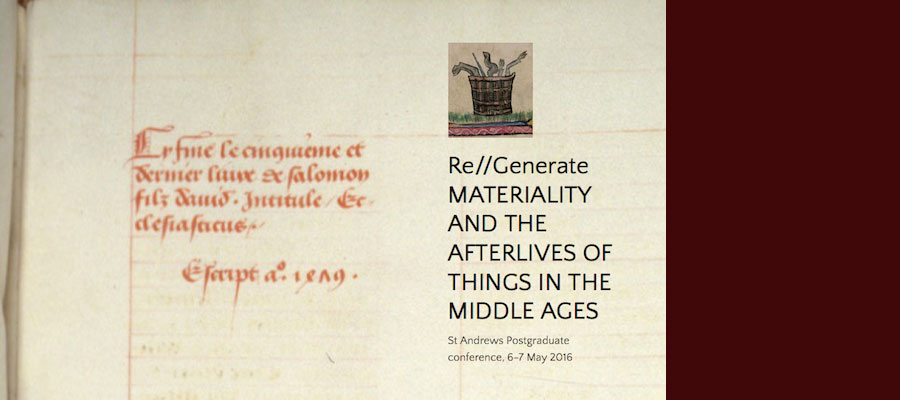Re/generate: Materiality and the Afterlives of Things in the Middle Ages, 500–1500, St Andrews Postgraduate Conference, University of St Andrews, May 6–7, 2016
The University of St Andrews School of Art History in collaboration with the St Andrews Institute of Medieval Studies (SAIMS) present Re/generate: Materiality and the Afterlives of Things in the Middle Ages, 500-1500, an interdisciplinary conference on reuse and recycling in medieval Europe taking place on 6-7th May 2016.
In recent years, the discipline of Art History has been grappling with the concept of materiality, the very thingness of art. The material of medieval art, be it parchment, precious metal, gem, bone or stone, has emerged as a spearheading topic. Unsurprisingly, this “material turn” has prompted intriguing questions. To what extent does an ivory figure of the Virgin and Child embody the divine, rather than merely represent it? What exactly did pilgrims do with the holy dust or liquid which they carried away from saints’ shrines in little ampullae? It is within this context that we wish to explore how recycling was part of the medieval (re)creative process.
This conference will investigate the different ways in which medieval people used and reused goods, materials, and other elements from existing forms to create (or recreate) new art and architecture. Why did medieval people preserve, conserve, and recycle art and materials from a different era? Did such appropriation go beyond mere economic practicality? Could the very materiality of an object have been the reason for its retention or reinvention? The two-day conference is aimed at postgraduates and early career academics from a range of disciplines including, but not limited to history, art history, museum studies, archaeology, book studies and literature.
We invite twenty-minute papers on the following range of topics and their relationship to the study of materiality, recycling and reuse in middle ages:
- Second-hand materiality of medieval art and/or everyday objects;
- The concept of refuse/garbage and its reuse;
- The medieval and post-medieval afterlives of things;
- Theoretical approaches to medieval materiality; Thing theory and Stuff theory;
- Semiotics and anthropology of medieval recycling and recreation;
- Issues of authorship, circulation and ownership of recycled art;
- Genealogy of recycled materials: spoils, heirlooms, relics, ruins and remnants;
- Conservation, preservation and restoration in medieval thought and practice.
Papers on other issues related to the study of materiality and reuse of materials in the Middle Ages or of medieval materials in post-medieval practice are also welcome.
